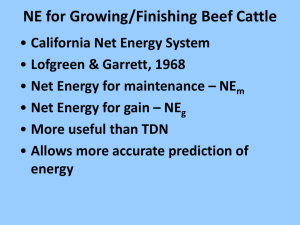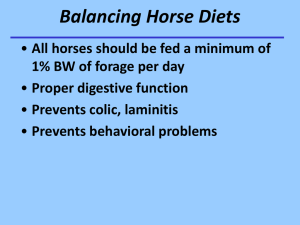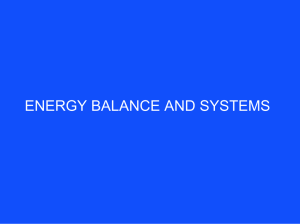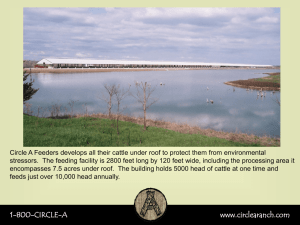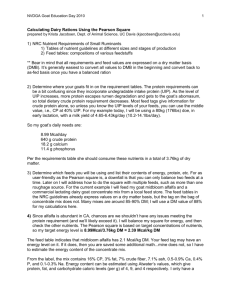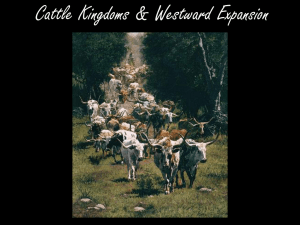Hoagland-WinterFeedingofBeefCows-March2013
advertisement
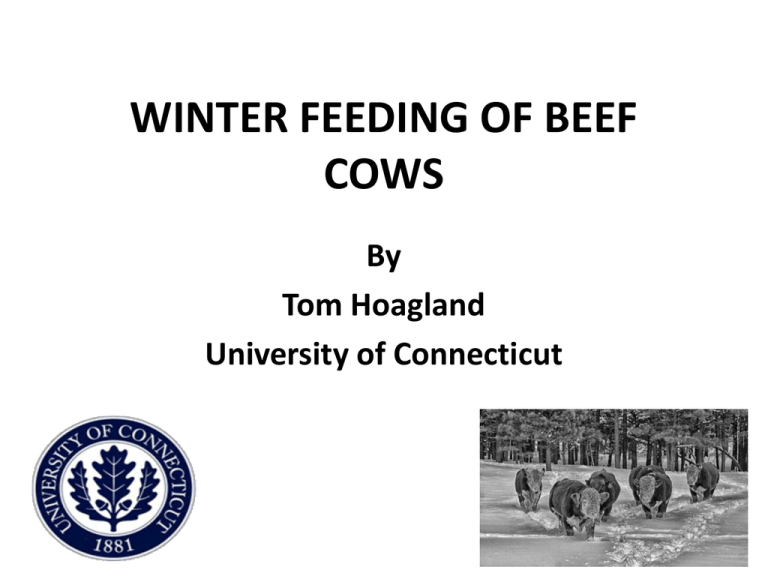
WINTER FEEDING OF BEEF COWS By Tom Hoagland University of Connecticut Water consumption at different environmental temperatures Schematic of the influence of ambient temperature with HE (heat production) and IE (intake energy). RE is energy for production. TABLE 12 Summary of Voluntary Food Intake of Beef Cattle in Different Thermal Environments 15 to 25°C Preferred values as tabulated in Nutrient Requirements of Beef Cattle. •5 to 15°C Intakes up 2 to 5 percent. •-5 to 5°C Intakes up 3 to 8 percent. •-15 to -5°C Intakes up 5 to 10 percent. •< - 15°C Intakes up 8 to 25 percent. •Intakes during extreme cold (< -25°C) or during blizzards and storms may be temporarily depressed. •Intake of high roughage feeds may be limited by bulk. TABLE 14: Water Requirements of Beef Cattle in Different Thermal Environments •15 to 25°C 3 to 5 kg water per kg DM intake. •Young and lactating animals require 10-50 percent more water. •-5 to 15°C 2 to 4 kg water per kg DM intake. •< -5°C 2 to 3 kg water per kg DM intake. •Increases of 50-100 % occur with a rise in ambient temperature following a period of very cold temperature, e.g., a rise from -20 to 0° C. ADJUSTMENTS TO FEEDING VALUES FOR TEMPERATURE STRESS A = B + B(Cf(T-20)) A = value adjusted for environment, B = diet component value from NRC feed composition table, Cf: correction factor (see below), and T = effective ambient temperature (°C). Cf for Effect of Temp on Diet Component Dry matter 0.0016 Energy components (ME, NE, TDN) 0.0010 Acid detergent fiber 0.0037 Nitrogen (crude protein) 0.0011 Example of Adjustment to the Feeding Value of Alfalfa Hay for Feeding to Beef Cattle Exposed to Warm (30C), Neutral (20C), and Cold (-5) Environmental Conditions Temperature (°C) ME (Mcal/kg) NEm (Mcal/kg) NEg (Mcal/kg) TDN (%) Digest protein (%) 30 1.94 1.14 0.40 53.5 11.5 20 1.92a 1.13 0.40 53.0 11.4 a From Table 11, NRC, 1976a. -5 1.87 1.11 0.39 51.7 11.1 Net Energym = aW0.75 where NEm = net energy for maintenance (Mcal/day), a = 0.077 for TNZ, W = live weight (kg). For each °C prior exposure to ambient temperatures above or below 20°C, 0.0007 should be subtracted or added respectively to a in the above equation. Thus, for cattle with prior exposure to temperatures of 30, 20, 10, and 0°C, the value a becomes 0.070, 0.077, 0.084, and 0.091, respectively. This means that a 1400 lb cow at 0°C will need 18 % more net energy maintenance in her feed. Adjustments directly to NEm , ME or TDN Adjustments can be made directly to the NEm and maintenance energy requirement values expressed in terms of ME or TDN by decreasing (for heat) or increasing (for cold) the tabulated values by 0.91 % for each °C the cattle have had prior extended exposure to conditions above or below 20°C. Lower Critical Temperature Need to make adjustments when ambient temp is below LCT LCT for Beef Cows is lower than for other livestock Cold stress is generally not a practical nutritional problem in beef cattle Cold Hardiness of Beef Cattle Large size Effective thermal insulation Large heat increment from digestion and metabolic processes Storms and Blizzards Bigger Problem Causes an immediate increase in energy requirement Depends on level of acclimatization Cold Acclimatized Cattle Increased metabolic rate Enhanced ability to increase their metabolic heat production Calculating Actual LCT Must be established to make nutritional adjustments for cold stress LCT = Tc – I(HE – He) where LCT = lower critical temperature (°C), Tc = core temperature (°C) (39°C satisfactory assumption), I = total insulation, i.e., tissue plus external, (°C/Mcal/m2/day), HE = heat production (Mcal/m2/day), and He = heat of evaporation (Mcal/m2/day). HE = (ME – NEp)/A where HE = heat production (Mcal/m2/day), ME = metabolizable energy intake (Mcal/day), NEp = net energy for production (Mcal/day), and A = surface area (m2). NOTE: Surface area may be calculated from body weight according to the general formula A(m2) = 0.09 kg0.75. ME* = A(LCT –T)/I where ME* = increase in maintenance energy requirement (Mcal/day), A = surface area (m2), LCT = lower critical temperature (°C), T = effective ambient température (°C), and I = total insulation, i.e., tissue plus external TABLE 16 Estimates of Tissue and External Insulation for Beef Cattle Tissue Insulation (It )a It (°C/Mcal/m2/day) Newborn calf 2.5 Month-old calf 6.5 Yearling 5.5 to 8.0 Adult cattle 6.0 to 12.0 External Insulation (Ie )b Wind Speed(mph) <1 4 8 16 Ie (°C/Mcal/m2/day) in Relation to Coat Depth <5 mm 10 mm 20 mm 30 mm 7 11 14 17 5 7.5 10 13.5 4 5.5 8 9 3 4 5 6.5 a Cattle in thin or emaciated body conditions and breeds with thin skins (dairy breeds and Bos indicus) have lower values than fat stock and breeds with thick skins (e.g., Hereford). b Presence of moisture, wet snow, or mud in the coat could reduce Ie in affected areas by 50 to 80 percent. Estimates of LCT , Increase in Energy Requirements of Beef Cattle Under Various ACUTE Stresses. Environmental Stresses weight LCT °C Increased Energy per °C below LCT Yearling Steer Gaining 1.1 kg/d Dry low wind 300 kg -34.1 (-29.4) 0.202 1.3% Yearling Steer Gaining 1.1 kg/d Wet snow, mud 10 mph wind 300 kg -9.5 (14.9) 0.310 2.0 % Dry Pregnant cow Middle third Dry low wind 500 kg -25.0 (-13) 0.237 1.45 % 0.334 2.04% Dry Pregnant cow 500 kg -7.3 (19) Middle third Wet snow 10 mph wind ____________________________________________________________________ Recommendations Feed More energy (~1.0 % more energy / drop in 1°C below 20 °C. Protect cattle from wind (or ↑25%). Wet and cold climates supply shelter and dry bedding (or ↑ 25%). Recommendations In Connecticut during Jan, Feb and March, beef cattle housed outside need to consume almost TWICE as much energy for maintenance. Adjustments of Non Energy Components Vitamin A requirement may increase with cold. Protein % may be decreased as feed intake increases to maintain amino acid requirements. Could increase roughage as heat increment will increase but don’t sacrifice performance for heat. Problem: Evaluation for a 500 kg dry cow pregnant cow in the last third of pregnancy on a diet of brome hay. Two environmental situations have been considered. Nonstressful conditions and a cold dry environment with seasonal temperatures of -15 ° C but during the past several days a winter storm with air temperatures of -25 ° C, 10 mph winds, drifting snow and lack of suitable bedding or shelter. nonstressful stressful Maintenance energy requirement (Mcal ME/day) adjusted for acclim temp adjusted for direct cold stress Total 16.4 (table) 0.0 16.4 21.6 5.9 27.5 Diet on dry matter basis energy adjusted for conditions (ME/kg) feed required for maintenance (kg/day) 1.87 8.8 1.79 15.4 Calculations: 16.4 +(16.4 (.91%)(20-(-15))) = 21.6 (.334)(-25-7.3) = 5.9 27.5/1.79 = 15.4 kg difficult to eat this much brome hay one TWO THREE FOUR FIVE SEVEN EIGHT SIX NINE
